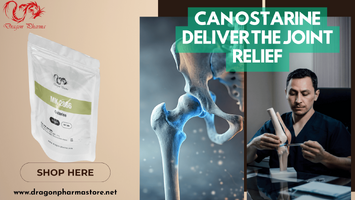Anabolix8
Board Rep
- Joined
- Dec 25, 2024
- Messages
- 330
- Reaction score
- 109
- Points
- 51
 Can Ostarine Deliver the Joint Relief and Recovery Benefits of TRT — Without the Lifelong Commitment?
Can Ostarine Deliver the Joint Relief and Recovery Benefits of TRT — Without the Lifelong Commitment? 
Joint pain is one of the most common reasons athletes scale back or leave the gym entirely.
Over time, repetitive strain, microtears, and inflammation break down connective tissue — leaving even experienced lifters feeling older than their age.
Testosterone Replacement Therapy (TRT) often becomes a go-to solution when recovery slows and joint discomfort grows. While it restores hormonal balance and improves collagen synthesis, TRT comes with a major caveat: once you begin, you rarely stop. Natural testosterone production typically remains suppressed, locking users into a lifelong regimen.
But what if there were a middle ground — something that could provide many of the same musculoskeletal benefits, without the permanent dependency? That’s where Ostarine (MK-2866) has sparked growing interest.
Understanding Ostarine’s Mechanism of Action
Ostarine is a Selective Androgen Receptor Modulator (SARM) designed to target muscle and bone tissue selectively — stimulating anabolic activity while minimizing the androgenic side effects seen with steroids or full hormone replacement.
Research indicates that Ostarine binds to androgen receptors in muscle and connective tissue, enhancing protein synthesis, nitrogen retention, and collagen turnover. Unlike exogenous testosterone, it does not convert to DHT or estrogen at significant levels, meaning users avoid most hormonal side effects like hair loss, acne, or gynecomastia.
Scientific Evidence Supporting Joint and Tissue Repair
In a Phase II clinical trial conducted by GTx, Ostarine demonstrated measurable increases in lean body mass and functional performance among elderly subjects within 12 weeks. Though the primary goal was muscle preservation, a significant portion of participants reported improved joint comfort and mobility — likely linked to Ostarine’s influence on collagen metabolism and intra-articular fluid retention.
Additional animal studies show Ostarine’s potential to accelerate the healing of tendons, ligaments, and bone microfractures, offering a strong rationale for its off-label interest among bodybuilders recovering from injuries.
Ostarine vs. TRT: Key Differences
- 1. Hormonal Dependence: TRT requires continuous administration; once started, endogenous testosterone production remains suppressed. Ostarine can be cycled, and natural testosterone can be restored with a proper PCT.
- 2. Collagen & Tissue Impact: Both enhance collagen synthesis, but Ostarine’s effect is localized, offering targeted joint benefits without systemic hormonal imbalance.
- 3. Lipid and Hematocrit Effects: TRT often elevates hematocrit and impacts cholesterol; Ostarine tends to produce minimal changes in short-term use.
- 4. Accessibility & Adaptability: TRT requires medical supervision, while Ostarine (for research purposes) remains more flexible for short-term recovery protocols.
Clinical and Anecdotal Observations
Athletes commonly report:
- Decreased chronic elbow, knee, and shoulder discomfort within 2–3 weeks
- Enhanced recovery speed post-training or injury
- Fuller, hydrated joint feel during training
- Noticeable muscle retention during calorie deficits
In comparison, TRT users often experience more systemic effects — increased libido, mood enhancement, and energy — but the joint benefits are gradual and tied to stable hormone levels over months.
Potential Downsides and Considerations
While Ostarine is gentler than anabolic steroids, it still suppresses natural testosterone at higher or prolonged doses (over 12–16 weeks). Mild lipid shifts can occur, and some users report fatigue post-cycle if not supported by an effective PCT.
Those seeking the best of both worlds — improved joint function without hormonal dependency — typically use Ostarine in moderate doses (10–20 mg/day) for 6–8 weeks, followed by a short recovery phase.
The Bottom Line
Ostarine presents a compelling, research-supported alternative for individuals seeking to protect joints, maintain lean mass, and avoid the lifelong commitment of TRT. It’s not a replacement for clinical hormone therapy — but it can be a bridge between natural performance and assisted recovery.
For those exploring research-grade compounds like Ostarine for recovery and joint health, verified options are available through Dragonpharmastore — trusted by experienced lifters and researchers alike.




